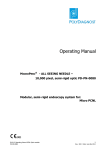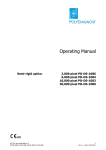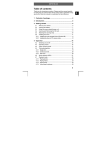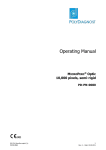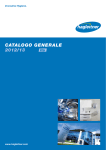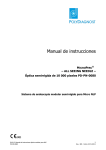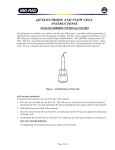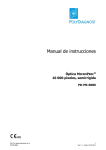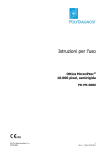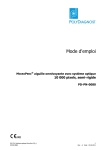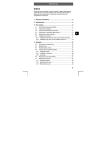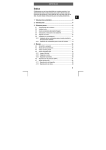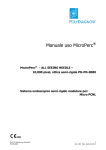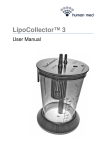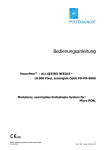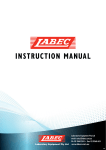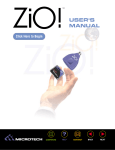Download User`s Manual - PolyDiagnost
Transcript
Operating Manual Semi-rigid optic: 10,000 pixel, PD-DS-1083 Dental Modular Endoscope Modular, semi-rigid endoscopy system for: Dental Procedures Root canal and dental implantology 0483 PH 01.2 Operating Manual Semi-rigid Optic modular, Dental PD-DS-1083 1 Rev.: 001 Date: April 24, 2012 All rights reserved. This operating manual contains information that is protected by the manufacturer. It is prohibited to copy this operating manual and to take sections of the text or duplicates without prior written permission by POLYDIAGNOST GmbH. The manufacturer reserves the right to make changes and updates to the manual. Due to the continued development of our products, it is possible that technical specifications or images in this operating manual do not correspond to the current state of production. As manufacturer of the endoscopes, POLYDIAGNOST GmbH assumes no responsibility whatsoever for any damages to the devices, nor for damages caused by the faulty use of the endoscope and by not adhering to this operating manual. Service and repair work on the devices may only be carried out by the manufacturer or by a maintenance company authorized and appointed by POLYDIAGNOST GmbH. Opening the instruments or having repairs carried out by non-authorized persons will void all safety and warranty claims. POLYDIAGNOST GmbH POLYDIAGNOST Entwicklungs-, Produktions-, Vertriebs- und Servicegesellschaft für medizinelektronische Diagnostik- und Therapiegeräte mbH Schäfflerstr. 13 D-85276 Pfaffenhofen / Ilm www.polydiagnost.com [email protected] PH 01.2 Operating Manual Semi-rigid Optic, Dental PD-DS-1083 Tel.: Fax: +49 84 41 / 80 60 – 0 +49 84 41 / 80 60 – 60 2 Rev.: 001 Date: April 24, 2012 Table of Contents Page 1 Safety ....................................................................................................................... 5 1.1 Intended application .................................................................................................. 5 1.2 Operating manual ...................................................................................................... 5 1.3 Compatibility with other devices .................................................................................. 5 1.4 Important information ................................................................................................ 5 1.5 On receiving the Dental Modular Endoscope ................................................................. 5 1.6 Reconditioning and storage......................................................................................... 6 1.7 Sterile packaged products ........................................................................................... 6 1.8 Repair / exchange ...................................................................................................... 6 1.9 Compatibility ............................................................................................................. 6 2 Specifications ............................................................................................................ 7 3 Product description .................................................................................................... 8 3.1 Overview................................................................................................................... 8 3.2 Individual description ................................................................................................. 9 4 Functional elements ................................................................................................. 10 4.1 POLYDIAGNOST – semi-rigid modular optic 10,000 pixel Dental Modular Endoscope ......... 10 4.2 Preparation of the Dental Modular Endoscope ............................................................ 10 4.3 Labeling .................................................................................................................. 13 5 Instruments............................................................................................................. 13 6 Preparation for the use of the endoscopy system ........................................................ 15 6.1 Preparation for use of endoscope system – see figure 3. ............................................. 15 7 Operation of the endoscopy system ........................................................................... 16 7.1 Preparation of the dental modular endoscope ............................................................. 16 7.2 Inspection of the modular endoscope ........................................................................ 16 7.3 Basic equipment ...................................................................................................... 16 7.4 Checking the endoscopic image................................................................................. 16 8 Troubleshooting ....................................................................................................... 17 8.1 Occurrence of an error ............................................................................................. 17 8.2 Sending endoscope / instrument in for repair ............................................................. 17 9 Instructions for reconditioning .................................................................................. 18 9.1 General statement ................................................................................................... 18 9.2 Safety information ................................................................................................... 18 9.2.1 Basics ..................................................................................................................... 18 9.2.2 Terminology ............................................................................................................ 19 9.2.3 Causes of a faulty reconditioning ............................................................................... 19 9.3 Cleaning, disinfection and sterilization........................................................................ 19 9.3.1 Basics ..................................................................................................................... 19 PH 01.2 Operating Manual Semi-rigid Optic, Dental PD-DS-1083 3 Rev.: 001 Date: April 24, 2012 9.3.2 Precautionary measures ........................................................................................... 20 9.3.3 Reconditioning overview ........................................................................................... 21 9.3.4 Pre-cleaning immediately after the examination .......................................................... 21 9.3.5. Manual cleaning and disinfection ............................................................................... 22 9.3.6. Machine cleaning and disinfection (disinfector) ........................................................... 24 9.3.7 Sterilization ............................................................................................................. 26 9.3.8 High Level Disinfection in Dental Clinics ..................................................................... 27 9.3.9 Material compatibility ............................................................................................... 28 9.4 Storage of Dental Modular Endoscope and accessories ................................................ 30 9.5 Service life .............................................................................................................. 31 10 Transporting the endoscope...................................................................................... 31 10.1 Transport inside the hospital ..................................................................................... 31 10.2 Transport outside the hospital ................................................................................... 31 10.3 Transporting the endoscope by using a shipping company / transport company ............ 31 11 Certificates .............................................................................................................. 32 PH 01.2 Operating Manual Semi-rigid Optic, Dental PD-DS-1083 4 Rev.: 001 Date: April 24, 2012 1 Safety 1.1 Intended application For endoscopic diagnosis and therapy of dental procedures e.g. root canal treatment and dental implantology as well as other dental-related procedures. 1.2 Operating manual Before using the endoscope, please thoroughly read the operating manual as well as the operating manuals of all other necessary devices that are to be used during the examination. The different endoscopic procedures and the medical aspects of endoscopy are not a part of these instructions. Keep the operating manual in a safe, easily accessible place. If you have questions or suggestions about the content of this operating manual, please contact the company POLYDIAGNOST or its distribution partners. 1.3 Compatibility with other devices The safe operation of endoscopy devices depends in large part on the correct selection of other devices. The combination with any devices other than the recommended ones can lead to an impairment of safety and performance. 1.4 Important information The user has to check and decide whether the endoscope is the right model for the intended examination. A prerequisite for the safety of patients is the proper handling of the endoscope by the doctor and the medical personnel. Examples of improper behavior: Using insufficiently prepared or wrongly stored devices increases the risk of infection of the patient and personnel. Forcing the endoscope forwards or backwards without a clear endoscopic view can lead to injury to the patient. The insertion and / or use of endoscopic accessories without a clear endoscopic view can lead to injury to the patient. 1.5 On receiving the Dental Modular Endoscope Check the endoscope for damages and for proper functionality. Do not use the endoscope if there are any visible damages and / or if the functionality is not guaranteed. If you notice any irregularities, please contact your POLYDIAGNOST customer representative. WARNING: The endoscope was not sterilized or disinfected before delivery. It must be cleaned and disinfected / sterilized before every use, as described in the corresponding chapter of the manual. PH 01.2 Operating Manual Semi-rigid Optic, Dental PD-DS-1083 5 Rev.: 001 Date: April 24, 2012 1.6 Reconditioning and storage After use, recondition the endoscope and store it according to the general guidelines. (See chapter “Instructions for reconditioning”.) Insufficient reconditioning can create an infection risk and cause damage to the device. Attention: The optic is not autoclavable. Autoclaving will damage the optic. 1.7 Sterile packaged products When using sterile packaged products, make sure that the sterile packaging is undamaged. If the packaging is damaged, the products may not be used. 1.8 Repair / exchange This endoscope contains no parts to be serviced by the user. Do not make any changes to the endoscope or attempt to repair it, as this can lead to putting the patient at risk or can damage the device. (See chapter “Troubleshooting”.) 1.9 Compatibility Our products may contain nickel and / or latex. Care must be taken in case of relevant allergies. In such cases, the use of the device is up to the doctor’s judgment. PH 01.2 Operating Manual Semi-rigid Optic, Dental PD-DS-1083 6 Rev.: 001 Date: April 24, 2012 2 Specifications Figure 1 – Dental Modular Endoscope with protective tube for optic 10,000 pixel optic, 120° Article number: PD-DS-1083 Exterior diameter: 0.93 mm Image control system: 10,000 pixel Viewing direction: 0°, direct view Field of vision: 120° Optic length: Standard light connection: 151 mm ACMI adapter Integrated fiber-optic lighting Reinforced nitinol optic Operating conditions Room temperature Rel. humidity Air pressure PH 01.2 Operating Manual Semi-rigid Optic, Dental PD-DS-1083 10 – 40 C (50 – 104 F) 30 – 85% 700 – 1060 mbar 7 Rev.: 001 Date: April 24, 2012 3 Product description 3.1 Overview POLYDIAGNOST’s semi-rigid optic system is a complete Dental Modular Endoscopy system. A completely usable endoscopy system for dental procedures consisting of the following: 1. 2. 3. 4. 5. 6. 7. Modular optic, 10,000 pixel, PD-DS-1083 with optic protection tube (PD-HS-0204) Dental handle (PD-DS-1310) Optic shifter 26 mm (PD-DS-1210) Modular ocular fix-focus black (PD-FS-4001 POLYSHAFTS® dental, 2.3 mm (root canal) PD-DS-1070 POLYSHAFTS® dental, 3.3 mm (implant) PD-DS-1075 Optional sterilization tray (PD-AC-1013) for preparation and storage Figure 2 PH 01.2 Operating Manual Semi-rigid Optic, Dental PD-DS-1083 8 Rev.: 001 Date: April 24, 2012 3.2 Individual description Modular optic 10,000 pixel Optic shifter 26 mm PD-DS-1210 Dental handle, PD-DS-1310 POLYSHAFT® 25 mm Ø 2.30 mm autoclavable PD-DS-1070 Application All dental procedures Root canal PH 01.2 Operating Manual Semi-rigid Optic, Dental PD-DS-1083 POLYSHAFT® 25 mm Ø 3.30 autoclavable PD-DS-1075 Application All dental procedures Root canal Dental implantology 9 Rev.: 001 Date: April 24, 2012 4 Functional elements 4.1 POLYDIAGNOST – semi-rigid modular optic 10,000 pixel Dental Modular Endoscope Modular ocular fixfocus Optic body Optic Light cable connection Handle dental POLYSHAFT® dental Irrigation channel Working channel Shifter Optic Kink protection Figure 3 4.2 Preparation of the Dental Modular Endoscope The sterilized endoscope with protective tube is put in place. Figure 4 The protective tube is removed. Figure 5 PH 01.2 Operating Manual Semi-rigid Optic, Dental PD-DS-1083 10 Rev.: 001 Date: April 24, 2012 Optic shifter (autoclaved) Figure 6 Dental handle (autoclaved) Figure 7 Selected POLYSHAFT® dental Figure 8 The shifter is slid onto the optic and fixed on the proximal end using the screw. Figure 9 Example A: Next, slide the optic including the shifter into the selected channel of the handle, in example A the middle entrance point, and firmly connect it to the shifter using the Luer Lock of the handle. Figure 10 Slide POLYSHAFT®dental onto optic and connect it to the handle. Figure 11 B A Length compensation of the optic using the shifter: A) Shifter B) Fixing screw Figure 12 PH 01.2 Operating Manual Semi-rigid Optic, Dental PD-DS-1083 11 Rev.: 001 Date: April 24, 2012 If the optic sticks out of the POLYSHAFT® dental, the screw B (figure 13) is loosened and the optic set exactly onto the distal end of the POLYSHAFT® dental using the shifter. This is checked using the monitor image. Next, the screw B is fixed again. Figure 13 POLYSHAFT® dental with the optic set to the distal end. Figure 14 PH 01.2 Operating Manual Semi-rigid Optic, Dental PD-DS-1083 12 Rev.: 001 Date: April 24, 2012 4.3 Labeling The respective serial number, manufacturer and CE-label are indicated on the body of the optic and the modular ocular. Serial number Manufacturer CE-label Figure 15 Serial number and CE-label Figure 16 Manufacturer Figure 17 5 Instruments The micro-instruments developed by POLYDIAGNOST can be inserted through the working channel of the handle. The diameter of the optic and instruments must be adjusted to the exterior or interior diameter of the POLYSHAFT®. Attention: Instruments that can be opened or closed must always be closed when they are inserted into or pulled out of the working channel. The insertion and / or use of endoscopic accessories without a clear endoscopic view can lead to injury to the patient. Forced insertion of instruments into the working channel can damage the endoscope. Please note that reconditioning is not permitted for the products marked “single-use”. PH 01.2 Operating Manual Semi-rigid Optic, Dental PD-DS-1083 13 Rev.: 001 Date: April 24, 2012 Sterilization tray: PD-AC-1013 Please note that only PolyDiagnost holders are permitted for the sterilization tray. Figure 18 Shiftable irrigation / suction catheter: PD-DS-0505 Exterior diameter: 0.8 mm sterile, single-use Figure 19 Luer Lock cap set of 5 pieces: PD-CA-0609 disposable / sterile packed Figure 20 cleaning brush for the optic shifter: PD-TD-0020 set of 5 pieces Figure 21 cleaning brush for the handle: PD-TD-0030 set of 5 pieces Figure 22 PH 01.2 Operating Manual Semi-rigid Optic, Dental PD-DS-1083 14 Rev.: 001 Date: April 24, 2012 6 Preparation for the use of the endoscopy system Carefully read the operating manual for every accessory device and prepare the device according to the respective specifications. 6.1 Preparation for use of endoscope system – see figure 3. Once the optic has been cleaned, disinfected/sterilized and is ready for use remove the protection tube Slide the optic shifter onto the optic and fix on the proximal end using the fixation screw Slide the optic including the optic shifter into the middle channel of the handle. Slide the POLYSHAFT® dental onto the optic and connect to the handle. If the optic protrudes out of the POLYSHAFT® dental, open the fixation screw on the optic shifter, and adjust the optic to be exactly at the distal end of the POLYSHAFT® dental. Irrigation devices are placed through the side ports of the handle Attach the modular ocular to the optic body and tighten the ring of the ocular in place. Connect TV adaptor to the modular ocular Connect the camera head to the TV adaptor Attach the light cable to the light cable entrance on the optic body The setup of the light source/camera/monitor should be according to the manufacturer's manual/instructions. Llight cable with exchangeable adapters for light source and endoscope. Figure 23 TV-adaptor Figure 24 Camera head and cable Figure 25 PH 01.2 Operating Manual Semi-rigid Optic, Dental PD-DS-1083 15 Rev.: 001 Date: April 24, 2012 7 Operation of the endoscopy system → Endoscopic procedures and the medical aspects of endoscopy are not a part of this operating manual. 7.1 Preparation of the dental modular endoscope Make sure that the endoscope was cleaned, disinfected and sterilized before use, as described in the chapter “Instructions for reconditioning”. 7.2 Inspection of the modular endoscope Before every use, check the endoscope for recognizable damages and functionality. Examine the device visually to make sure it is in perfect condition and check the image quality of the ocular, together with the endoscope. Do not use the endoscope if you notice irregularities, if there are any visible damages and / or if the functionality is not guaranteed. WARNING The use of a defective or imperfectly functioning endoscope can form a hazard to the safety of the patient. 7.3 Basic equipment X X X Monitor Video camera, camera head with cable and TV adaptor Metal Halide, or LED light source Carefully read the operating manual for every accessory device and prepare the device according to the respective specifications. 7.4 Checking the endoscopic image Switch on the video camera, light source and monitor and check the endoscopic image. After switching on the entire system (camera / light source / monitor), switch the light source to the highest intensity. Hold the distal end of the semi-rigid optic approx. 5 cm above a white surface and adjust the white balance with the help of the corresponding switch on the camera. Then hold the distal end of the optic at the same distance above a “colorful graphic” and adjust the focus with the adjustable ring on the TV adapter. At the same time, check the color fidelity. If the image is cloudy, clean the lens of the ocular with a cotton swab soaked in 70% alcohol (ethanol or isopropanol). PH 01.2 Operating Manual Semi-rigid Optic, Dental PD-DS-1083 16 Rev.: 001 Date: April 24, 2012 If the endoscopic image disappears on the monitor during the examination, there are three possible causes: 1) The camera is defective – or there is an operating error 2) The light source is defective – or there is an operating error 3) If the diagnostic image disappears and instead a “crystal-structured image” appears on the monitor, this indicates a defect in the fiber-optic system. This does not pose a risk to the patient. Remove the endoscope by slowly pulling it out. Conclude the examination and inform the POLYDIAGNOST service. 8 Troubleshooting 8.1 Occurrence of an error If the endoscope does not work perfectly, check the endoscope, as described in the chapter “Operation of the endoscopy system”. If the problem can not be eliminated, please consult your technician or your POLYDIAGNOST customer representative. If the endoscope is obviously damaged, please consult your POLYDIAGNOST customer representative. ATTENTION: Repairs or changes that were not carried out by PolyDiagnost lead to the voiding of all warranty claims. POLYDIAGNOST assumes no warranty for the functionality of endoscopes, devices or instruments whose repair was not carried out by POLYDIAGNOST. POLYDIAGNOST assumes no liability for injuries or damages that occur after repair attempts that were not carried out by POLYDIAGNOST. 8.2 Sending endoscope / instrument in for repair Before sending in the endoscope or instrument, please request a repair authorization number from our POLYDIAGNOST customer representative. You can send the endoscope / instrument in for repairs using this repair authorization number. Please include a description of the error and the phone number of the contact person with the shipment. Important: Endoscopes, instruments and devices must be thoroughly cleaned and disinfected / sterilized before they are sent in for repair. Include a written confirmation. Insufficiently reconditioned devices represent an infection risk for anyone who comes into contact with them. That is why we reserve the right not to accept contaminated endoscopes, instruments and devices. PH 01.2 Operating Manual Semi-rigid Optic, Dental PD-DS-1083 17 Rev.: 001 Date: April 24, 2012 9 Instructions for reconditioning 9.1 General statement With regard to decontamination, different requirements apply in different parts of the world. One also has to be aware that in some countries the law requires that all used endoscopes and instruments must be guaranteed to be free of prions. RKI guidelines: The Robert-Koch-Institute (RKI) has published guidelines for the preparation of applied medical products. All instructions for reconditioning published by the company POLYDIAGNOST are subject to the guidelines of the RKI. First, a brief overview of the required processing steps from the RKI guidelines: Proper preparation (gathering, possibly disassembling, pre-treating and pre-cleaning) of the used medical products and their transport to the location of the preparation, safely enclosed and in a way that avoids damages, Cleaning, disinfection, irrigation and drying, Checking for cleanliness and sound condition of the surfaces (e. g. corrosion, material quality) and possibly identification for the purpose of making a decision about a reconditioning, Care and maintenance, Verification of the technical/functional safety, Labeling, Packaging and sterilization, Storage. 9.2 Safety information 9.2.1 Basics This operating manual contains information that is necessary and critical for the safe and effective reconditioning of the endoscope and its accessories. Read this operating manual carefully and follow the instructions. Keep all operating manuals in a safe, easily accessible place. All persons responsible for the reconditioning must be trained thoroughly in: - the the the the the the reconditioning procedures that are used work safety regulations national and local hospital guidelines operating manual function of the endoscopy equipment labeling of disinfectants PH 01.2 Operating Manual Semi-rigid Optic, Dental PD-DS-1083 18 Rev.: 001 Date: April 24, 2012 9.2.2 Terminology Microorganisms Bacteria, yeasts, fungi and viruses Microorganisms may not be found on surgical instruments and endoscopes (infection risk) Cleaning Physical/chemical elimination of impurities (including organic substances) Disinfection Reduction of the number of microorganisms with the objective of having as few microorganisms as possible survive (“low-germ” = product of low microbiological contamination) Sterilization Reduction of the number of microorganisms with the objective of having no microorganisms survive (sterile product) Sterile Absence of viable microorganisms (very high certainty that less than one microorganism will survive on a million products) 9.2.3 Causes of a faulty reconditioning Medical literature reports about patients’ infection and contamination with the following causes: Rushing the reconditioning procedure or aborting it altogether Not adhering to mandatory prescribed concentrations and application times Use of unsuitable chemicals Incompatible cleaning and disinfectant solution Misjudging the consequences that may occur as a result of improper reconditioning Insufficiently reconditioned and prepared devices and/or cleaning, disinfectant solutions (pay attention to holding times!) 9.3 9.3.1 Cleaning, disinfection and sterilization Basics Effective pre-cleaning, cleaning and disinfection are an indispensable prerequisite for an effective sterilization of POLYDIAGNOST endoscopes and accessories. Make sure that only cleaning, disinfection and sterilization procedures that are sufficiently validated with regard to devices and products are used, and that the validated parameters are adhered to in every cycle. Also make sure that the regulations of the hospital and the manufacturer of the cleaning products and disinfectants, the disinfectors and the sterilizers, as well as the statutory provisions applicable in your country are adhered to. This applies in particular for the different specifications with regard to an effective prion inactivation. PH 01.2 Operating Manual Semi-rigid Optic, Dental PD-DS-1083 19 Rev.: 001 Date: April 24, 2012 WARNING: The endoscope was not sterilized or disinfected before delivery. It must be cleaned and disinfected / sterilized before every use. ATTENTION: In case of thermostable devices and instruments, the autoclaving of gas sterilization is to be preferred. 9.3.2 Precautionary measures ATTENTION If the endoscopic devices are not cleaned and disinfected or sterilized according to regulations, then this can pose a risk to the safety of the patient. During application, the endoscope comes into contact with mucous membranes. To contain the risk of a transfer of diseases as much as possible, the endoscope must always be subjected to a thorough cleaning after every examination, followed by a disinfection and/or sterilization. If the cleaning is omitted, then this undermines the effectiveness of disinfection and sterilization. Endoscopes and accessories must be cleaned as thoroughly as possible before disinfection or sterilization. Thorough cleaning reduces the number of microorganisms present, eliminates organic materials and thus supports the effectiveness of the disinfection or sterilization procedure. For the mechanical cleaning of openings and channels, POLYDIAGNOST makes corresponding cleaning brushes available for the different channel diameters. Contact your POLYDIAGNOST representative. The contact with secretions of the patient and reconditioning chemicals can pose a danger to your health. During reconditioning, always wear the prescribed protection gear, as specified in the hospital or national regulations. Suitable protection gear is: protective goggles, face guard, moisture-resistant protective clothing or lab coat (note: soiled lab coats must be taken off before leaving the reconditioning area), chemical-resistant, water-proof gloves that are the right size and sufficiently long. Gloves must be exchanged and disposed of on a regular basis. Irrigate the channels thoroughly and carefully. To be free of disinfectants, all internal channels of the handles and the shifter must be irrigated thoroughly with sterile or low-germ distilled or de-ionized water. This prevents the next patient from being exposed to residues of disinfectants. Make sure that the reconditioning area is sufficiently ventilated, as specified in the hospital or national work safety regulations. Sufficient ventilation (at least eight to ten air changes per hour) reduces chemical fumes. For the drying or irrigation of the channels with air or liquid, do not use pressures greater than 50 kPa, otherwise the channels can be damaged. PH 01.2 Operating Manual Semi-rigid Optic, Dental PD-DS-1083 20 Rev.: 001 Date: April 24, 2012 9.3.3 Reconditioning overview after examination pre-cleaning in examination room cleaning / disinfection in preparation room manual cleaning / disinfection machine cleaning / disinfection testing / maintenance packaging sterilization storage 9.3.4 Pre-cleaning immediately after the examination A pre-cleaning has to take place immediately after the examination, while the device is still in the examination room. This is the only way to prevent the depositing of organic material can be prevented and to guarantee successful sterilization. 1. Remove all instruments, valves and caps from the working channels. 2. Clean the exterior surfaces of the endoscopy system with a soft cloth or sponge soaked in disinfectant. 3. Disassemble the modular endoscopy system into its individual parts: optic, handle and shifter. 4. Irrigate all internal channels of the handle and of the shifter with disinfectants. 5. Clean the lens (distal end) of the semi-rigid optic by lightly rubbing it with a damp swab. PH 01.2 Operating Manual Semi-rigid Optic, Dental PD-DS-1083 21 Rev.: 001 Date: April 24, 2012 6. Place the optic protection tube onto the modular, semi-rigid optic. 7. Then irrigate with disinfectant solution, see figure 26. Figure 26 The cleaning and disinfection must take place immediately after the application and the precleaning. This is where different procedures can be used: - Machine procedure (disinfector) or - Manual procedure (placing device in cleaning products and disinfectants). Note: Due to the low reproducibility and effectiveness a manual cleaning and disinfecting should only take place if no disinfector is available. 9.3.5. Manual cleaning and disinfection When selecting the cleaning products and disinfectants, care must be taken that - the disinfectant has a verified effectiveness (e. g. DGHM/ÖGHMP or FDA certification or CE-label) - the cleaning product is compatible with the used disinfectant - the used chemicals are compatible with the POLYDIAGNOST endoscopy devices and accessories Important: The concentrations and application times indicated by the manufacturer of the cleaning product or disinfectant must be absolutely adhered to. When irrigating after disinfection only use sterile or low-germ (max. 10 germs/ml) distilled or deionized water. Semi-rigid optic, endoscopy accessories and other parts should not be placed in physiological saline solution and should not be cleaned in ultrasonic bath. This immediately leads to damages on the endoscope and its accessories. Only freshly produced cleaning, disinfection and irrigation solutions may be used, and they may not be used more than once. To clean the surfaces and internal channels, do not use brushes or sponges made of metal, as this can cause damages. PH 01.2 Operating Manual Semi-rigid Optic, Dental PD-DS-1083 22 Rev.: 001 Date: April 24, 2012 Cleaning: 1. Fill a basin with the cleaning solution. 2. Place the disassembled POLYDIAGNOST endoscopy system into the cleaning solution. The endoscope must be completely submerged. Place semi-rigid optic with protective tube in place (as depicted) into cleaning solution. A syringe filled with cleaning products or disinfectants is placed on the Luer Lock of the protective tube and the tube with optic inside is irrigated multiple times. Figure 27 3. Clean the exterior surfaces of the endoscopy system with a soft cloth or sponge. 4. Clean the internal channels of the handle and shifter multiple times with the respectively suitable cleaning brushes inside the cleaning basin. Always brush from the proximal end to the distal end. 5. Make sure that the cleaning solution does not foam too much (reduced cleaning effectiveness). 6. Irrigate all channels forcefully and thoroughly with cleaning solution at least five times (singleuse syringe). 7. Take the endoscopy system out of the cleaning bath as soon as the application time recommended by the manufacturer of the cleaning product has passed. 8. Next, irrigate all channels at least five times using sterile or low-germ distilled or de-ionized water (single-use syringe). Duration per irrigation cycle at least 1 minute. 9. Next, dry all channels by blowing medically clean compressed air through. Disinfection: 1. Fill a basin with the disinfectant solution. 2. Place the disassembled POLYDIAGNOST endoscopy system into the disinfectant solution. The endoscope must be completely submerged. (see also figure 27) 3. Disinfect the exterior surfaces of the endoscopy system with a soft cloth or sponge. 4. Irrigate all channels thoroughly with disinfectant solution at least five times (single-use syringe). 5. Take the endoscopy system out of the disinfection bath as soon as the application time recommended by the manufacturer of the disinfection product has passed. 6. Next, irrigate all channels at least five times using sterile or low-germ distilled or de-ionized water (single-use syringe). Duration per irrigation cycle at least 1 minute. 7. Next, dry all channels by blowing medically clean compressed air through. PH 01.2 Operating Manual Semi-rigid Optic, Dental PD-DS-1083 23 Rev.: 001 Date: April 24, 2012 The fundamental suitability of the POLYDIAGNOST endoscopy devices for an effective manual cleaning and disinfection was verified by an independent test lab, using the cleaning product CIDEZYME1 (application concentration 1.6 %, application time 5 min) and the disinfectant CIDEX1 (undiluted, activated solution, application time 30 min). The procedure described above was taken into account during this. 1 Johnson & Johnson Medical GmbH, Norderstedt 9.3.6. Machine cleaning and disinfection (disinfector) When selecting the disinfector, care should be taken that - the disinfector has a verified effectiveness (e.g. DGHM/ÖGHMP or FDA certification or CElabel) - the disinfector has connections for the operating and irrigation channels of the POLYDIAGNOST endoscopy system - only sterile or low-germ (max. 10 germs/ml) distilled or de-ionized water is used for irrigation. - that the disinfector is maintained and inspected on a regular basis. When selecting the disinfection program, care should be taken that - for thermolabile products, the corresponding program is selected - the irrigation pressures used for the operating and irrigation channels are not too high (see 9.3.2 Precautionary measures: do not use pressures greater than 50 kPa) - the program contains sufficient irrigation cycles. When selecting the used cleaning products and disinfectants, care must be taken that - the disinfectant has a verified effectiveness (e. g. DGHM/ÖGHMP or FDA certification or CElabel) - the cleaning product is compatible with the used disinfectant, and - the used chemicals are compatible with the POLYDIAGNOST endoscopy devices and accessories. Important: The concentrations and application times indicated by the manufacturer of the cleaning product or disinfectant must be absolutely adhered to. When irrigation after the disinfection only use sterile or low-germ (max. 10 germs/ml) distilled or de-ionized water. PH 01.2 Operating Manual Semi-rigid Optic, Dental PD-DS-1083 24 Rev.: 001 Date: April 24, 2012 Important: Even when using machine cleaning and disinfection, a manual pre-cleaning must endoscope and endoscopic accessories must take place according to RKI guidelines. For this, follow steps 1 to 9 of the “Cleaning” section in chapter “9.3.5 Manual cleaning and disinfection”. Only once this is done should you proceed as follows: 1. Place the disassembled POLYDIAGNOST endoscopy system into the disinfector using the sterilization tray. Make sure that the devices are not damaged during this. Sort instruments and accessories properly on machine-suitable instrument screens. 2. Connect the operating and irrigation channels to the connecting tubes on the disinfection basket. 3. Start the program. Note the indications by the manufacturer. 4. Remove the endoscopy system once the program has finished. 5. If necessary allow the endoscopy system to continue to dry. The fundamental suitability of the POLYDIAGNOST endoscopy devices for effective machine cleaning and disinfection was verified by an independent test lab, using the disinfector Hamo LS-20001 (program no. 89, 50 °C), the cleaning product Korsolex Endo-Cleaner2 (concentration 150 ml /30 l, application time 5 min) and the disinfectant Korsolex Endo-Disinfectant2 (concentration 300 ml/30 l, application time 10 min). The procedure described above was taken into account during this. 1 2 Hamo AG, Switzerland Bode Chemie GmbH, Hamburg After cleaning, disinfection, rinsing and drying: Check for cleanliness and sound condition of the surfaces (e. g. corrosion, material quality) and permeability of the interior channels, possibly identification for the purpose of making a decision about a repeated reconditioning or disposal, Maintenance, Verification of the technical/functional safety. PH 01.2 Operating Manual Semi-rigid Optic, Dental PD-DS-1083 25 Rev.: 001 Date: April 24, 2012 9.3.7 Sterilization Only previously cleaned, disinfected and completely dried POLYDIAGNOST endoscopy devices and accessories may be sterilized. The products must be placed in the sterilization tray before sterilization. Care must be taken during this that the products are not bent or damaged. The sterilization tray is then to be packaged in a suitable sterilization packaging (single-use sterilization packaging for the intended sterilization procedure) according to DIN EN 868-2 or DIN EN ISO 11607-1. The original -sterilization tray of the POLYDIAGNOST features holding brackets to avoid mechanical damage to unfixed devices. For sterilization, only the sterilization procedure listed below are to be used; other sterilization procedures are not permissible: Ethylene oxide gas sterilization (55 °C to max. 60 °C) and formaldehyde gas sterilization Semi-rigid optic (in the sterilization tray) Handles, shifters X X X X X X with protective tube ®1 STERRAD (low-temperature plasma sterilization) with protective tube Autoclave (steam sterilization) 121 °C, 20 minutes (max. 124 °C) Autoclave (steam sterilization) 132 / 134 °C, 5 minutes (max. 137 °C) 1 registered trademarks of the corresponding manufacturers (X = permissible) ATTENTION: In case of thermostable devices and instruments, autoclaving is to be preferred to gas sterilization. Ethylene oxide (EO) – gas sterilization Only use an ethylene oxide sterilizer that meets the specifications of DIN EN 1422 and a sterilization procedure that was validated according to DIN EN ISO 11135-1. The principal proof of the suitability of the endoscopes for an effective ethylene oxide sterilization was provided by an independent test lab using the Sterivit procedure by the company DMB Apparatebau GmbH, Wiesbaden. The procedure indicated above was taken into account during this. When determining the post-run ventilation times, you must follow the specifications of DIN EN ISO 10993-7. PH 01.2 Operating Manual Semi-rigid Optic, Dental PD-DS-1083 26 Rev.: 001 Date: April 24, 2012 The principal proof of a relatively low ethylene oxide residue of the used materials directly after the ethylene oxide sterilization was provided by an independent test lab using the Sterivitprocedure of the company DMB Apparatebau GmbH, Wiesbaden. The procedure indicated above was taken into account during this. Attention: Repeated ethylene oxide sterilization can reduce the service life of the endoscope. An effective and certified sterile packaging and suitable storage can prevent unnecessary repeated sterilizations. Autoclaving (steam sterilization) Only use a steam sterilizer that meets the specifications of DIN EN 285 or DIN EN 13060 and a sterilization procedure (fractionated vacuum procedure) that was validated according to DIN EN ISO 17664-1. 9.3.8 High Level Disinfection in Dental Clinics The Dental Modular Endoscope is a heat sensitive device and incompatible with the traditional steam sterilization method available in dental clinics. For this reason, high level disinfection (HLD) is recommended for reprocessing the endoscope. Before performing HLD on the endoscope, the pre-cleaning and cleaning instructions outlined in this chapter must be carried out. High Level Disinfection (HLD) 1. 2. 3. 4. 5. Fill a basin with the HLD solution. Place the disassembled endoscope (ie. remove the POLYSHAFT® dental, dental handle and optic shifter from the endoscope) in to the HLD solution. The endoscope must be completely submerged. The concentration and application/soaking times indicated by the HLD manufacturer must be adhered to. Remove the endoscope from the HLD solution once the application/soaking time recommended by the HLD manufacture has passed. Immerse the endoscope in sterile or low-germ distilled or de-ionized water and then rinse the endoscope with sterile or low-germ distilled or de-ionized water three times. Dry the endoscope thoroughly with compressed air. When using HLD solutions check the following: The HLD solution is compatible to the cleaning products used The HLD has verified effectiveness The HLD chemicals are compatible to the PolyDiagnost endoscope device and accessories The concentration and application times indicated by the HLD manufacturer must be absolutely adhered to Autoclave (Steam Sterilization) Accessories of the endoscope; the dental handle, POLYSHAFT® dental, optic shifter can undergo autocalve (steam sterilization) as mentioned in this chapter. Prior to autoclave (steam sterilization) the pre-cleaning, cleaning and disinfection instructions outlined in this operating manual must be carried out. PH 01.2 Operating Manual Semi-rigid Optic, Dental PD-DS-1083 27 Rev.: 001 Date: April 24, 2012 9.3.9 Material compatibility Due to continued advances in technical development, it is not possible to guarantee that this list is complete. That is why we recommend the tested and approved disinfectants (type 1) and cleaning products (type 2) in the following list: Manual cleaning and disinfection / sterilization: Product name Manufacturer Type ® Advanced Sterilization Products c/o Johnson & Johnson Medical GmbH 2 Cidex OPA Advanced Sterilization Products c/o Johnson & Johnson Medical GmbH 1 ® Bode Chemie GmbH 1 ® Bode Chemie GmbH 1 ® Bode Chemie GmbH 1 Sekusept Extra N ® Ecolab GmbH 1, 2 ® Ecolab GmbH 1 Sekusept Plus ® Ecolab GmbH 1, 2 Instru Plus Laboratorium Dr. rer. nat. Deppe 1 Instru Star Laboratorium Dr. rer. nat. Deppe 1, 2 Instru Zym CIDEZYME ® Aseptisol Korsolex AF Korsolex Plus Sekusept Forte gigasept Laboratorium Dr. rer. nat. Deppe 2 ® Schülke & Mayr GmbH 1 ® Schülke & Mayr GmbH 1 gigasept FF PH 01.2 Operating Manual Semi-rigid Optic, Dental PD-DS-1083 28 Rev.: 001 Date: April 24, 2012 Machine cleaning and disinfection / sterilization: Product name Manufacturer Type BHT Scope Cleaner BHT Hygienetechnik GmbH 2 BHT Scope Disinfectant BHT Hygienetechnik GmbH 1 ® Bode Chemie GmbH 2 Korsolex Endo-Cleaner ® Bode Chemie GmbH 2 ® Bode Chemie GmbH 1 neodisher Septo DN ® Dr. Weigert GmbH & Co. KG 1 ® Dr. Weigert GmbH & Co. KG 1 Sekumatic FD Ecolab GmbH 1 Endomat Plus Laboratorium Dr. rer. nat. Deppe 1 3E-Zyme Dismoclean 24 Vario Korsolex Endo-Disinfectant neodisher Septo DA ® Medisafe UK, Ltd. 2 ® Schülke & Mayr GmbH 1 ® Schülke & Mayr GmbH 2 ® Schülke & Mayr GmbH 2 thermosept ED thermosept ER thermosept RKN-zym Attention: When selecting the cleaning products and disinfectants, please take care that they do not contain the chemicals listed here: - Aromatic hydrocarbons - Hydroxylamin - Weak and strong mineral acids - Isobutanol - Weak and strong organic acids - Isopropanol - Oxidizing acids - Iodine and iodine tincture - Strong lye - Iodine starch solution - Acetone - Lime potash - Ethanol - Potassium bifluoride - Ethyl acetate - Potassium hypochlorite - Ethylene glycol - Calcium hypochlorite - Battery acid 10% - Nitrohydrochloric acid (aqua regia) - Formic acid - Copper-II-chloride - Longer-chain alcohols from 3C atoms - Methanol - Aluminum chloride - Methylene chloride - Ammonium concentrates - Methyl ethyl ketone - Ammonium bifluoride - Mineral lubricants - Aniline hydrochloride - Monochloroacetic acid - Antimony chloride - Sodium hydroxide (10%) and conc. - Benzine - Sodium hypochlorite - Benzoic acid - Nicotinic acid - Benzene - Nitrobenzene PH 01.2 Operating Manual Semi-rigid Optic, Dental PD-DS-1083 29 Rev.: 001 Date: April 24, 2012 - Bromine - Perchloroethylene - Bromine water > 1% - Perchloric acid - Hydrogen bromide - Phenol solution - Butanol - Phosphoric acid (10%) - Chlorine - Mercury-II-chloride - Chlorinated lime - Nitric acid (10%) - Chloric acid - Hydrochloric acid (10%) - Chlorosulfonic acid - Sulfuric acid (10%) and conc. - Chloroform - Styrol - Chromic acid - Terpentine - Chromosulfuric acid - Hydrogen tetrachloride - Dimethylformamide - Toluol - Iron-III-chloride - Trichlorethane - Acetic acid 10% and conc. - Trichlorethylene - Hydrogen fluoride - Hydrogen peroxide (30%) - Hydrofluoric acid - Xylol - Formaline (30%) - Tin ammonium hexachloride - Glycol und glycolic acid - Citric acid 9.4 Storage of Dental Modular Endoscope and accessories - The storage space must be low-germ, low on dust, dry and well ventilated. Temperature fluctuations should be avoided. - Do not store the semi-rigid endoscope in the transport case. - Store the endoscope in the supplied protective tube and properly in the sterilization tray or a suitable storage tray. The same goes for the accessories. This reduces the risk of damages. - Before putting them away for storage, thoroughly dry all parts of the dental modular endoscope and the accessories. - The handle, shifter and accessories are to be stored separately from endoscope. - Storage in direct sunlight, at high temperatures or where they are affected by X-rays can damage the POLYDIAGNOST endoscope or accessories or pose an infection risk. PH 01.2 Operating Manual Semi-rigid Optic, Dental PD-DS-1083 30 Rev.: 001 Date: April 24, 2012 9.5 Service life The service life of the products is not unlimited. It is determined by the frequency of use and the quality of storage. In case of proper storage, usage, cleaning, disinfection and sterilization, a service life of 3 years can be assumed. Important note: POLYDIAGNOST has made every effort to manufacture an endoscope with a maximum service life. Still, an unlimited durability can not be guaranteed. The quality and service life of the device in large part depends on the careful handling and proper maintenance by a well-trained team. 10 Transporting the endoscope 10.1 Transport inside the hospital Transport the modular, semi-rigid optic properly in the sterilization tray or a suitable storage tray. The same goes for the accessories. This reduces the risk of damages. If you need to transport the device without a suitable tray, hold the optic body and the optic in the protective tube in one hand and make sure that the light cable has a large radius to avoid kinks. 10.2 Transport outside the hospital Transport the endoscope in the transport case. Make sure that the endoscope is placed carefully in the cut-outs in the case that are intended for this purpose and that this is not closed if the light cable juts out over the edge of the case. ATTENTION: The transport case can not be cleaned or disinfected. Clean and disinfect or sterilize the endoscope before placing it in the transport case. Before using the endoscope, it must be disinfected or sterilized again. 10.3 Transporting the endoscope by using a shipping company / transport company Important: In case of any damage incurred during transport, please pay careful attention to the following directions, since the insurance company covering the transport is not obligated to pay for any claims if these formal requirements are not adhered to. If there are damages during transport, it is in your interest to secure compensation claims by involving representatives of the shipping company / transport company in a timely manner to determine the damages in the context of their relevant rules and regulations. This means that if a loss or damage of the product is externally recognizable, then the recipient has to demonstrate the loss or damage to the freight carrier no later than at the time the goods are delivered. In case of transport by rail, the railroad company must be asked for a statement of the facts. In case of a parcel shipment, any damaged parcels must be recorded in writing by the shipping company before they are accepted. PH 01.2 Operating Manual Semi-rigid Optic, Dental PD-DS-1083 31 Rev.: 001 Date: April 24, 2012 In case of damages that are not immediately recognizable, i.e. that are only discovered when unpacking the goods, the shipping company or freight carrier must be notified in writing immediately. The use of the following text is recommended for the required correspondence to the transportation company: To the dispatch office in......................................................................... (or to the post office, the shipping company, the transportation company, the parcel service) The shipment.............................................. (indication of letter of consignment, package, signature) from...................................... (sender) to......................................., received on........................., was accepted here without complaint since no externally recognizable damages were evident. On opening the package, however, it turned out that the content was damaged and / or lost during transport. We hold you responsible for the damage that was incurred. If you think it is necessary, you can inspect the extent of the damage in our company premises / our storage facilities ..............................................................................................................(address). Please also contact the department in our company that sent you the shipment, specifying the letter of consignment and the invoice number, and please enclose the mentioned documents with your complaint. 11 Certificates Certification: 0483 CE: This device meets the requirements of the Council Directive 93/42/EEC regarding medical products. This device is a product of class IIa. PH 01.2 Operating Manual Semi-rigid Optic, Dental PD-DS-1083 32 Rev.: 001 Date: April 24, 2012
































